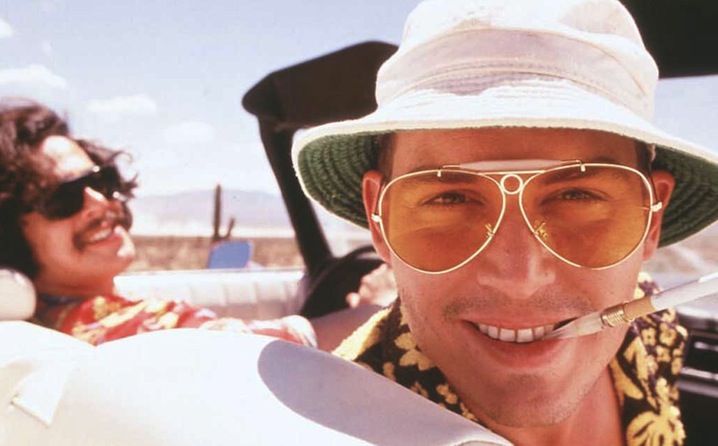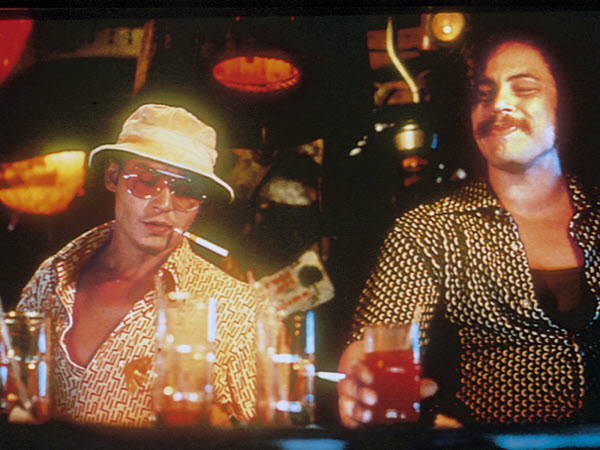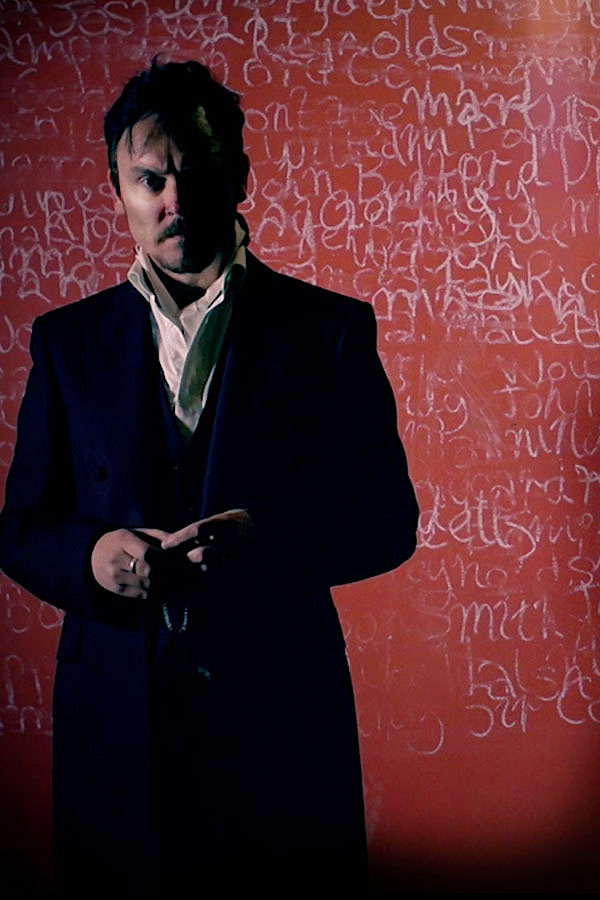
Ashley Thorpe. Photo courtesy of Carrion Films.
British filmmaker Ashley Thorpe’s trilogy of terror, SCAYRECROW, THE SCREAMING SKULL and THE HAIRY HANDS, earned a Visionary Award at Atlanta’s Buried Alive Film Festival in 2010. All three shorts produced by Ashley’s Carrion Films were set in the fascinating mythos of Dartmoor in Devon, a place so layered in fog and legend that people literally were known to disappear into its mists and never be seen again until they returned as ghosts. But it wasn’t just the rich subject matter that turned heads here in Atlanta, it was the unique look achieved through rotoscope animation, which particularly in SCAYRECROW, the tale of a haunted highwayman who rises from the dead to avenge his lover, also evoked Hammer Films’ horror movies of the ‘60s and ‘70s in its texture.
Ashley wasn’t able to attend the last Buried Alive but sent a trailer for his next film BORLEY RECTORY, a documentary short on a Suffolk manor that has a reputation as the “Most Haunted House in England.” Since then, he’s attached veteran actor Julian Sands (WARLOCK, GOTHIC and a guest at DragonCon 2013 next week) as the narrator and Steven Severin, one of the founding members of Siouxsie and the Banshees and now an acclaimed composer/accompaniest for silent films, to create the score, and is in the midst of an Indiegogo crowd-source campaign to fund the project which has the potential to launch Ashley to the next level. Meanwhile he’s also writing and painting some cool covers for Fangoria magazine, and yes, he has several features in preproduction as well – HELL-TOR, an Amicus-inspired portmanteau, and SPRING HEELED JACK, based on the Victorian London legend.
Beyond his talent as a filmmaker, Ashley’s one of the nicest chaps we know and the Indiegogo campaign is in its final push through Aug. 31, so well, we just couldn’t resist making him Kool Kat of the Week.
ATLRetro: Your past films are based on legends of Dartmoor near your home town of Exeter in Devon. Can you talk a little about how growing up in such a haunted area has influenced the arc of your filmmaking?
Ashley Thorpe: I was surrounded by local myths and ghost stories and specifically elderly couples eager to tell them! It seemed like an inevitability that most social get-togethers – especially at a country pub – would end with a grisly ghost story or two. Though I initially dreaded these chilling stories – in fact I’d often go and hide in the toilet until they were over – I now feel very lucky to have been “exposed” to these diverse tales of ghosts, demons and devilry at a young age as they’ve absolutely inspired and influenced pretty much my entire body of work, in there in my mind, a nest of tiny scorpions breeding in my cranium!
 I think it’s because it’s a landscape that is simultaneously very beautiful and yet potentially very dangerous. It’s romantic and it’s deadly. And what’s more. Dartmoor has always felt to me like a region that has been precariously tamed. We may have civilized the outskirts by posting churches on the boundaries, but it’s really still a wilderness out there. Tales of the devil are common in this region and are more often than not pre-Christian. For instance, the actual tale of the demonic Huntsman and his pack of hellish Whisht hounds that I referenced in THE DEMON HUNSTMAN [ Glass Eye Pix’s TALES FROM BEYOND THE PALE radio theater series] is based upon a genuine Dartmoor myth that I’d heard as a kid, and its origin I suspect is probably prehistoric. It’s an ancient legend bound in the conflict between Celtic and Christian religions; the benevolent horned gods of one age becoming the malevolent devils of another.
I think it’s because it’s a landscape that is simultaneously very beautiful and yet potentially very dangerous. It’s romantic and it’s deadly. And what’s more. Dartmoor has always felt to me like a region that has been precariously tamed. We may have civilized the outskirts by posting churches on the boundaries, but it’s really still a wilderness out there. Tales of the devil are common in this region and are more often than not pre-Christian. For instance, the actual tale of the demonic Huntsman and his pack of hellish Whisht hounds that I referenced in THE DEMON HUNSTMAN [ Glass Eye Pix’s TALES FROM BEYOND THE PALE radio theater series] is based upon a genuine Dartmoor myth that I’d heard as a kid, and its origin I suspect is probably prehistoric. It’s an ancient legend bound in the conflict between Celtic and Christian religions; the benevolent horned gods of one age becoming the malevolent devils of another.
I didn’t really appreciate how important the stories were to me until I’d moved away and lived in various cities and abroad, but it’s a land very close to my heart. I remember being told as a child that if all the unclaimed bodies, scattered in their shallow graves, rose from the moor, the dead would outnumber the living. Wonderful stuff! The earth out there is alive with their stories. The land has a thousand ghosts; all you have to do is listen.
Borley Rectory is in Suffolk, taking you away from Devon, but it’s also a story you discovered as a child. Can you talk a little about what drew you to it and made you want to make your next film about it?
I had the USBORNE BOOK OF GHOSTS as a boy, and although a great deal of the book frightened me, it was that moniker “The most haunted house in England” that really caught my imagination. I’d seen images of Harry Price debunking other supernatural phenomena in other mystery books, so for him to all but declare this as the pinnacle of ghostly phenomena made it seem all the more fascinating and scary. So the story has been with me again since childhood.
 I spent a couple of years working on radio scripts and developing a feature script and it had all become very laborious. I wanted to make a new short to remind myself why I loved doing this in the first place, and I chose Borley Rectory because I could picture it very visually and it seemed like a nice summation of what I’d attempted to do thus far. I’ve always loved vintage ghost photography, not just because of the subject material but primarily because they are often very beautiful images. I wanted to see if I could make a film that evoked similar sensations that are evoked by such photographs. It’s a story that is rich in gothic archetypes, so visually very strong with plenty of scope for the various apparitions.
I spent a couple of years working on radio scripts and developing a feature script and it had all become very laborious. I wanted to make a new short to remind myself why I loved doing this in the first place, and I chose Borley Rectory because I could picture it very visually and it seemed like a nice summation of what I’d attempted to do thus far. I’ve always loved vintage ghost photography, not just because of the subject material but primarily because they are often very beautiful images. I wanted to see if I could make a film that evoked similar sensations that are evoked by such photographs. It’s a story that is rich in gothic archetypes, so visually very strong with plenty of scope for the various apparitions.
BORLEY RECTORY has a rich history of hauntings from headless coachmen to a bricked-up nun, a screaming girl, and being built on the grounds of a Medieval monastery, the British equivalent of an ancient American Indian burial ground. Will you be portraying the house’s story more generally or focusing on a specific legend?
Very generally. The funny thing about Borley is that the Nun is the only ghost that seems to have any “back story” as such, with the other apparitions almost functioning as satellite phenomena. This film is going to be an introduction, a primer if you will, very much like the Usborne book that sparked my interest. It’s a “way in” to the legend. The historical data on Borley and the hauntings are incredibly rich and layered and dense, often contradictory and beset with duplicity, so I think to make something “definitive,” you’d have to do an HBO series on it. You could make an entire film just on Marianne Foyster, for instance! What I’m really interested in is trying to evoke the place, and explore what it was that attracted people to the Rectory and its legends – manifestations of desire, loss or some fatal flaw in character.
 The animation in your previous films, especially SCAYRECROW, owes an aesthetic debt to Hammer films, which you also grew up with. In the Indiegogo pitch, you talk about being fascinated with ghost photography. Will viewers of BORLEY RECTORY also see a Hammer influence or is this an indication that you will be taking a different direction?
The animation in your previous films, especially SCAYRECROW, owes an aesthetic debt to Hammer films, which you also grew up with. In the Indiegogo pitch, you talk about being fascinated with ghost photography. Will viewers of BORLEY RECTORY also see a Hammer influence or is this an indication that you will be taking a different direction?
Yes, SCAYRECROW is the one that is most obviously a love letter to Hammer horror, although I think THE HAIRY HANDS has aspects of an episode of the HAMMER HOUSE OF HORROR TV series. BORLEY RECTORY will be created in the same fashion as SCAYRECROW’ and THE SCREAMING SKULL, but visually will be quite the different animal. I’m really aiming for vintage ghost photography – glowing black and white imagery, images that conceal as much as they reveal, yet texturally very beautiful. On occasion, it may even veer into abstraction with only the narration keeping it grounded. Consider it my ultrasound of a haunted house!
You met Julian Sands through interviewing him for Fangoria, for which you’ve recently been a correspondent and cover artist. How did this blossom into Julian as narrator, and I understand he’d like to work with you on future projects as well?
Yes, indeed. I interviewed Julian for a retrospective I wrote on Ken Russell’s GOTHIC. Julian saw the films, loved them and asked me if I was working on anything. I’d literally just finished the first draft of BORLEY RECTORY, and so I asked him if he’d be interested in performing the narration and thankfully he said “yes.” Julian and I have loosely discussed working together on other projects, but future work will absolutely depend on the success of this campaign. If BORLEY RECTORY goes well, I’d love to develop the Dartmoor portmanteau feature HELL TOR, as there’s definitely a role in there for Julian.
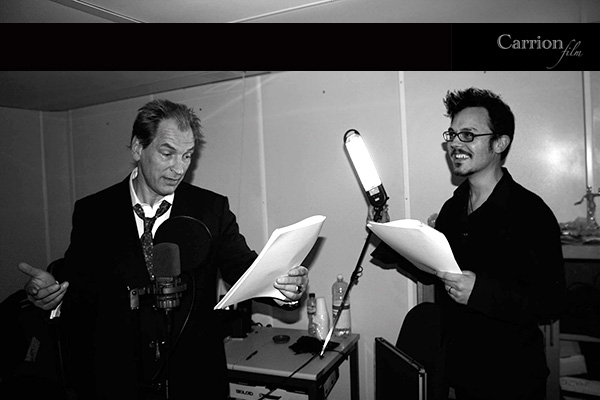
Julian Sands shares a laugh with Ashley Thorpe while recording the narration for BORLEY RECTORY. Photo courtesy of Carrion Films.
What about Steven Severin? Talk about a score in landing him to do the score. How did you get him on board?
That was Fangoria again, although believe it or not, I initially turned him down! Steven performed in Exeter, and I interviewed him about his score for Carl Dreyer’s VAMPYR. We kept in contact regarding the article [recently published in Fangoria #325], and then Steven asked me out of the blue if I’d had anyone in mind for the BORLEY RECTORY score. I was stunned. At the time, every film I’d made up to that point has been scored by my old friend Mick Grierson, so I initially said no! The Banshees are one of my favorite bands, but I explained that Mick was as much a part of Carrion as I am and that it would feel like a betrayal. Mick is a department head at Goldsmiths College in London, and as the year wore on, it became obvious that he just wasn’t going to be able to dedicate so much of his time to the film. However, Steven remained dead keen even after the long production hiatus, and a combination of circumstances and Mick’s academic responsibilities just really made the partnership at this time an obvious choice. I couldn’t be happier really. It’s very exciting to be working with Steven, and I’m looking forward to seeing what we can create together.
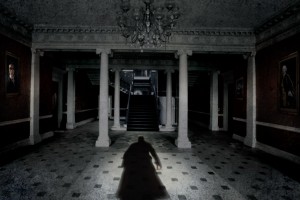
The entrance scene from THE SCREAMING SKULL. Photo courtesy of Carrion Films.
Reece Shearsmith also has joined the cast recently. I know not everybody over here knows who he is, but for those of us lucky ones who discovered the weird and wonderful LEAGUE OF GENTLEMEN, that’s quite exciting, too. How did he get involved and what role does he play?
Reece is amazing! He’s mainly known for his comedy grotesques, but he is an incredibly gifted actor. What’s more he’s also, like most of the League of Gentlemen team, an absolute dedicate of classic horror films. He’s a sincere fan, and we share many points of reference. His involvement came via a number of supporters like Derren Brown and Andy Nyman. I noticed that Reece had been tweeting support for our campaign so I tweeted a note of thanks. We got chatting, and he expressed real excitement for the project and the subject. So I just came out and asked him, and Reece, to my amazement, said yes. His involvement has really elevated the project. His fanbase are ravenous!
Reece will be playing the Daily Mirror journalist V.C Wall who was the journalist that really broke the story to the world in 1929, so a key role, and he’ll get to speak some wonderful and genuine news reports written by Wall from the period. I’m excited and simultaneously terrified to direct him! It’ll be fun. I have a feeling there’ll be a lot of horror nerd-outs!
You’ve also attracted some pretty amazing supporters such as Stephen Volk (screenwriter, GOTHIC), British mentalist Derren Brown, Robert Young (director, VAMPIRE CIRCUS) and comics writer Steve Niles. Have any in particular surprised or delighted you as the Indiegogo campaign progressed?
The support has been amazing actually and really quite diverse. Local support has been strong, but I’ve been slightly overwhelmed by the response internationally across the horror community. I’ve never been a fan of scenes as such, but the horror community have restored my faith in humanity after the film and TV industry gave it a good kick in last year! Stephen Volk and Johnny Mains have been incredibly supportive and generous with their time, and Chris Alexander [editor] at Fangoria has been there since the beginning. The support from Derren was great as he said a number of lovely things about SCAYRECROW when it came out back in 2008, so it’s a nice feeling to know that he’s still supportive, still watching. Indie filmmaking is tough so it’s invigorating, energizing to know that someone out there cares about what you’re doing or trying to do. Can’t do it without you!
 Crowd-sourcing has its rewards but also its challenges. You have more than 80 supporters and have raised over 5,000 pounds, but you did extend the fundraising period and reduce the target of the campaign from 20,000 pounds to 10,000 pounds. Will you have to turn to another source to make up the difference, or will you just be tightening the production’s belts.
Crowd-sourcing has its rewards but also its challenges. You have more than 80 supporters and have raised over 5,000 pounds, but you did extend the fundraising period and reduce the target of the campaign from 20,000 pounds to 10,000 pounds. Will you have to turn to another source to make up the difference, or will you just be tightening the production’s belts.
Yes, the extension was inevitable. I got hit with a very time-devouring contract to animate some feature titles shortly after the campaign launched, so as I was AWOL for a few weeks, I pushed the deadline back to the end of August. I reduced the target, too, as it became clear that we were going to struggle to reach 20K. We still may have to turn to other sources to make up the additional budget, or we may get started with what we raise and reevaluate later next year. Either way the budget has always affected me far more in terms of “time” rather than “quality.” Less money means less crew and more for the core to do. It will be distinctive and original whatever happens. “Don’t panic lads, we’ve been saved from casual mediocrity by lack of money again!” If we can’t afford horses, we’ll get the coconuts out again, ha ha. You know at no point during SCAYRECROW did any of us get on a horse. I spent much of it riding a tree trunk! You’ve gotta have that Terry Gilliam spirit to survive.
 You have some pretty cool perks for contributors. What’s your favorite and why?
You have some pretty cool perks for contributors. What’s your favorite and why?
I spent a long time working out the rewards, but I think my favorite HAS to be the limited edition vinyl of the Severin soundtrack. I mean that has to be the best fundraiser perk ever, hasn’t it? It was Steven’s idea actually. I made a mock-up for fun of what the soundtrack would look like if it had been released in the 70s with a very Pan Horror / Amicus style sleeve, and Steven went crazy for it, loved it and suggested that we try it for real, make it a super limited edition very special reward for investors. It’s going to be a beautiful thing. A real collectors’ item. Even if I don’t make a penny from BORLEY RECTORY, at least I’ll get one of those! The tour of Borley with author and publisher Johnny Mains is pretty amazing, too, plus you’ll be “written into” a Robert Aickman tribute collection to be published next year. That’s pretty amazing, too.
THE CONJURING, an old-fashioned haunted house movie, has been a big hit stateside. Does that encourage you that there’s a market for a return to atmospheric ghost stories in the horror film genre?
I think it’s great that a decidedly – perhaps archly – old-fashioned ghost story has made such an impact, but the audience has always been there, it’s just taken the market an age to catch up with what people really want as is so often the case. I think the market becomes less and less important as time goes on. The audience will find or indeed make its own entertainment. I didn’t start making the animations about neglected myths to get noticed; it was an attempt to tell the stories I wanted to hear. If you can find a way of telling your stories whilst bridging a cultural void, you’re onto a winner. Fingers crossed, eh?
Finally, would you like to share anything else about upcoming projects, such as HELL-TOR and SPRING HEELED JACK or your recent work with FANGORIA?
I’ve always loved the Amicus portmanteau, and when I initially started developing a feature, my first notion was to create one of my own. HELL-TOR is a collection of Dartmoor legends woven together. THE HAIRY HANDS was originally the book-end story, but ended up being developed into the short I produced with the Arts Council. ‘THE DEMON HUNTSMAN was mooted to be in there, too. The other three stories haven’t seen the light of day yet, although the kelpie / exorcism story, “Crows Mere,” was one of the first pitches for the second season of TALES BEYOND THE PALE. It’s definitely something I’d love to make. It would be a wonderful opportunity to get a British Horror portmanteau back on the screen. I should probably chat to Reece about this!
 My long term project is SPRING HEELED JACK – a Dickensian horror story – as opposed to the more familIar later period that sired Sherlock Holmes, Jekyll & Hyde and the Ripper crimes – and is inspired by the “genuine” boogeyman from the early 1800s. The tale of a rooftop bounding demon that could appear and disappear at will caught hold of the public imagination, becoming in time a popular character in Victorian fiction, in particular the Penny Dreadfuls [popular working class fiction] of the period who took the figure and transformed him from a shilling shocker phantom into an embryonic super-hero. With his crime -ighting exploits bedecked in bat-like cloak and horned cowl, it is difficult not to see him as anything other than the template of what would become Batman.
My long term project is SPRING HEELED JACK – a Dickensian horror story – as opposed to the more familIar later period that sired Sherlock Holmes, Jekyll & Hyde and the Ripper crimes – and is inspired by the “genuine” boogeyman from the early 1800s. The tale of a rooftop bounding demon that could appear and disappear at will caught hold of the public imagination, becoming in time a popular character in Victorian fiction, in particular the Penny Dreadfuls [popular working class fiction] of the period who took the figure and transformed him from a shilling shocker phantom into an embryonic super-hero. With his crime -ighting exploits bedecked in bat-like cloak and horned cowl, it is difficult not to see him as anything other than the template of what would become Batman.
I have been fascinated by the myths of Spring Heeled Jack and have often wondered why his presence on film has been so negligible. Apart from it being a delicious bit of British esoterica, the story fascinates me because it occurs in a period that has thus far pretty much only been defined by Dickens. It presents itself not only as an opportunity to explore early Victoriana – at a time when genre templates for horror and detective tales were coalescing in popular fiction – but a chance to make something akin to a classic “Hammer Horror” with a real underworld edge. The script is currently in development, and I have started pre-production character and concept art. I suppose if I could pitch it, I’d have to say it’s “Victorian Batman meets Sweeney Todd meets THE FLY!” It’s quite melodramatic, psychologically disturbing, a tale of a super hero becoming a super villain. It’s easily the darkest thing I’ve written, dark and dastardly – and deliciously deviant. I’d love to make it, a dream come true, but I have to be a midwife to history first!
To support or share the Indiegogo campaign for BORLEY RECTORY, click here. Watch SCAYRECROW for free on Vimeo here.
 CEMETERY MAN (1994); Dir. Michele Soavi; Starring Rupert Everett, Anna Falchi and François Hadji-Lazaro; Tuesday, February 18 @ 9:30 p.m. (photos and merch table open @ 9:00 p.m.); Plaza Theatre; Trailer here.
CEMETERY MAN (1994); Dir. Michele Soavi; Starring Rupert Everett, Anna Falchi and François Hadji-Lazaro; Tuesday, February 18 @ 9:30 p.m. (photos and merch table open @ 9:00 p.m.); Plaza Theatre; Trailer here. Francesco Dellamorte is the caretaker of the Buffalora cemetery, assisted by his mentally handicapped assistant Gnaghi, who can only speak the syllable “gna.” Dellamorte’s humdrum life consists of maintaining the grounds, crossing out the names of the dead from phone books and killing the reanimated corpses that rise after seven days of interment…all of which he undertakes with the same bored stoicism. It’s a job, after all, and shooting the zombies is easier than going through the paperwork needed to get any help. When he becomes infatuated with a young widow and Gnaghi falls for the mayor’s daughter, however, things take a turn for the worse.
Francesco Dellamorte is the caretaker of the Buffalora cemetery, assisted by his mentally handicapped assistant Gnaghi, who can only speak the syllable “gna.” Dellamorte’s humdrum life consists of maintaining the grounds, crossing out the names of the dead from phone books and killing the reanimated corpses that rise after seven days of interment…all of which he undertakes with the same bored stoicism. It’s a job, after all, and shooting the zombies is easier than going through the paperwork needed to get any help. When he becomes infatuated with a young widow and Gnaghi falls for the mayor’s daughter, however, things take a turn for the worse.

